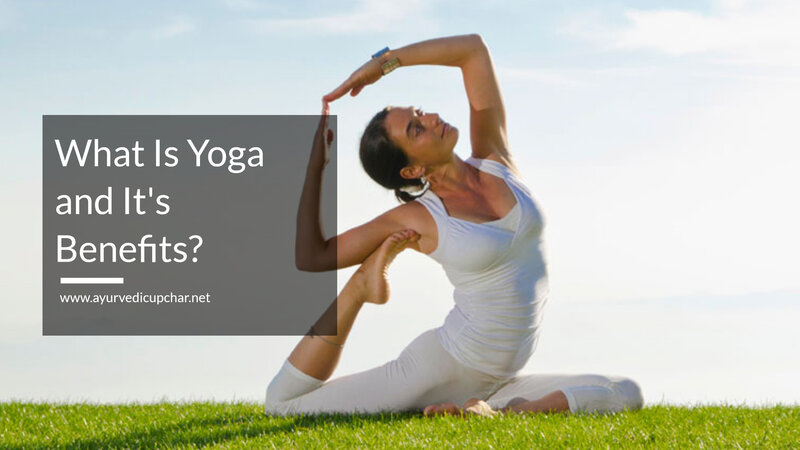What Is Yoga and It’s Benefits?

Yoga is a discipline that originated in India 2500 years ago and is still effective in bringing overall health and well being to any person who does it regularly.
The practice is the application of a set of concentration techniques that are practiced to achieve greater physical and mental control. Yoga is an age-old science made up of different disciplines of mind and body.
The word yoga is based upon the Sanskrit verb Yuja. It means to connect, to culminate, or to concur. It’s the culmination of mind and body or the culmination of Jiva and Shiva (soul and the universal spirit). It’s also a culmination of Purush and Prakriti (Yin and Yang).
What are the benefits of yoga?
There are so many benefits that yoga brings on a physical, mental, and emotional level, that it is said that its regular practice can change our lives
1. Reduce stress
Due to the standard of living of the current society, hurries, worries, traffic jams, and responsibilities. The body responds to this by generating cortisol, a hormone responsible for keeping the body on alert.
Thanks to the combination of action and relaxation in practice, this will allow us to immediately control the secretion of this hormone reducing stress.
2. Improves breathing
Due to the awareness of our own breathing, the main and fundamental aspect of Yoga, we will reduce the stress caused by our daily life. Stress affects breathing first of all.
So if we start to control this, we will be on the path to improving our physical and mental health. We will learn to change our breathing patterns and base ourselves on them to acquire relaxation and begin to notice changes in our organism.
Many postures and movements are based on the reduction in speed and deepening breathing; This practice activates the parasympathetic nervous system and increases the relaxation response.
3. Increase strength and endurance
In Yoga, we use all the muscles of our body. The regular practice of Yoga will allow us to develop our muscles, from the largest to the smallest, gaining strength and endurance. Along with the coordination of breathing and mind, Yoga becomes a very beneficial practice.
4. Increase flexibility
If we practice Yoga assiduously, the muscles will stretch more easily and the joints will increase their elasticity. With practice, this will be translated into greater agility and prevention of ailments that appear with age, as well as prevent the effects of daily postures, such as sitting in the office, driving, standing, etc.
5. It benefits the circulation
Thanks to the practice of Yoga, you will obtain benefits in your circulatory system, based mainly on postures and relaxation, and meditation exercises. Relying on the vinyasa, postures linked to the rhythm of breathing, we will obtain a much healthier heart.
6. Weight control
We must bear in mind that weight loss is the result of a balanced diet such as starting the morning with healthy breakfasts. As a consequence, it will help us in this process of mental control of our impulses and anxieties.
7. Regulates the nervous-endocrine system
Yoga helps to regulate and restore the balance of our nervous and endocrine systems. These are responsible for the process of reception, integration, and response of all types of information received by the body and mind.
8. Alleviate the pain
Several studies have shown that thanks to the practice of Yoga and its asana (postures) combined with relaxation and meditation, people with diseases or ailments get very considerable relief. If you are from people who have physical ailments, we encourage you to start your practice.
9. Development of consciousness
This is the great gift that Yoga offers us: the connection with the present moment. The more we practice, the more aware we become of our environment and the world around us. It directly benefits better concentration, coordination, reaction time, and memory.
10. Inner peace
It is the immediate result of the practice of Yoga and meditation. Cultivate inner peace and stillness. They are the basis for the other benefits of Yoga to have a real and authentic effect.
Who should take precautions?
Yoga in general is safe for most people. But it may be necessary to avoid some yoga poses or modify poses if you:
- Are pregnant
- Have high blood pressure
- Have glaucoma
- Has sciatica
Be sure to notify your yoga instructor if you have any of these conditions or any other injuries or medical problems. A qualified yoga teacher should be able to help you find poses that are safe for you.
Yoga styles
There are many different types or styles of yoga. These vary from mild to more intense. Some of the most popular styles of yoga are:
- Ashtanga or power yoga. This type of yoga offers a more demanding exercise. In these classes, you move quickly from one pose to another.
- Bikram or hot yoga. You do a series of 26 poses in a room with a temperature between 95 ° F and 100 ° F (35 ° C and 37.8 ° C). The objective is to warm and stretch the muscles, ligaments, and tendons, and to purify the body through sweat.
- Hatha yoga. This is sometimes used as a general term for yoga. It usually includes both breathing and postures.
- Integral. A gentle type of yoga can include breathing exercises, chanting, and meditation.
- Iyengar. A style that pays a lot of attention to precise body alignment. You can also hold the poses for extended periods of time.
- Kundalini. Emphasize the effects of breathing on postures. The goal is to release energy from the lower body so that it can travel upward.
- Viniyoga. This style adapts postures to the needs and abilities of each person and coordinates breathing and postures.
How to start
Find yoga classes at your local gym, health club, or yoga studio. If you are just starting yoga, start with a beginner class. Talk to the instructor before class and inform him of any injuries or conditions you may have.
You may want to ask about the instructor’s experience and training. However, while most instructors have had some formal training, there are no certified yoga training programs. Choose an instructor you enjoy working with who doesn’t push you in ways that make you uncomfortable.
What to expect
Most yoga classes last 45 to 90 minutes. All styles of yoga include three basic components:
- Breathing. Focusing on your breathing is an important part of yoga. Your teacher can offer instructions on breathing exercises during class.
- Postures Yoga poses, or positions, are a series of movements that help increase strength, flexibility, and balance.
- These range in difficulty from lying on your back on the floor to complicated balancing poses.
- Meditation. Yoga classes usually end with a short period of meditation. This calms your mind and helps you relax.
How to prevent injuries
While yoga is generally safe, you can still hurt yourself if you do a position incorrectly or push yourself too hard. Here are some tips for staying safe when doing yoga.
- If you have a medical condition, talk to your healthcare provider before starting yoga. Ask if there are any postures you should avoid.
- Start slowly and learn the basics before overexerting yourself.
- Choose a class that is appropriate for your level. If you are not sure, ask the teacher.
- DO NOT push yourself beyond your comfort level. If you cannot perform a position, ask your teacher to help you modify it.
- Ask questions if you are not sure how to take a position.
- Take a bottle of water with you and drink lots of water. This is especially important in hot yoga.
- Wear clothing that allows you to move freely.
- Listen to your body. If you feel pain or fatigue, stop, and rest.
Conclusion
It is a practice that will bring us benefits from the first day we started. It’s a sport that we can do anywhere If you can also choose a quiet and comfortable place, the experience will be much more positive. From areas near the pool, terraces, located near the golf course, as well as gym.
References
National Center for Complementary and Integrative Health website. Yoga: in depth.nccih.nih.gov/health/yoga/introduction.htm. Updated June 2013. Accessed August 13, 2018.
National Center for Complementary and Integrative Health website. 5 things you should know about yoga.nccih.nih.gov/health/tips/yoga. Updated September 24, 2015. Accessed August 13, 2018.























